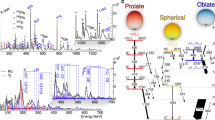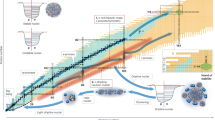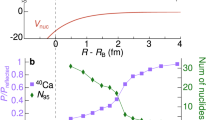Abstract
IT is a plausible hypothesis that the forces acting on a particle inside the nucleus are comparatively weak in the internal region and increase rapidly to the boundary of the nucleus, the potential distribution being represented by a hole with more or less flat bottom and rather steep walls1. If we approximate this model by a rectangular hole with infinitely high walls, the energy levels of a moving particle will be determined by the roots of Bessel functions and can be easily calculated. For the real model, however, this theoretical level system will be deformed owing to the fact that the walls are neither quite steep nor infinitely high, producing compression of the upper part of the level system.
This is a preview of subscription content, access via your institution
Access options
Subscribe to this journal
Receive 51 print issues and online access
$199.00 per year
only $3.90 per issue
Buy this article
- Purchase on SpringerLink
- Instant access to full article PDF
Prices may be subject to local taxes which are calculated during checkout
Similar content being viewed by others
References
Gamow, Proc. Roy. Soc., A, 128, 632; 1930.
Rutherford, Proc. Roy. Soc., A, 131, 684; 1931.
Ellis, Proc. Roy. Soc., A, 129, 180; 1930.
Taylor and Mott, Proc. Roy. Soc., A, 138, 665; 1932.
Author information
Authors and Affiliations
Rights and permissions
About this article
Cite this article
GAMOW, G. Nuclear Energy Levels. Nature 131, 433 (1933). https://doi.org/10.1038/131433a0
Issue date:
DOI: https://doi.org/10.1038/131433a0
This article is cited by
-
A phenomenological quark-antiquark potential
Il Nuovo Cimento A Series 10 (1967)
-
Fundamental State of Nuclear α-Particles
Nature (1933)



